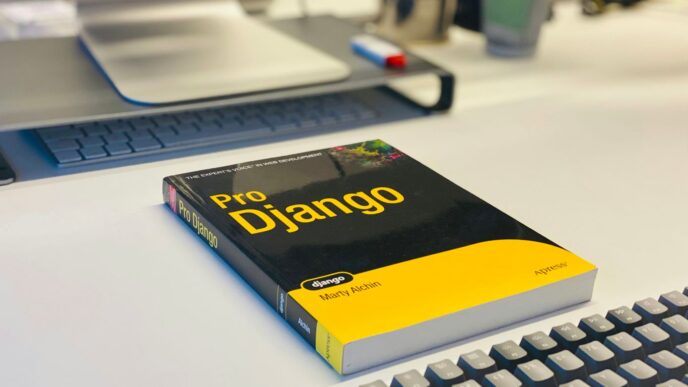Getting a handle on LeetCode can feel like a big task, especially when you’re starting out. But with the right approach and tools, it becomes much more manageable. Python, with its clear syntax and handy built-in features, is a fantastic language to use for tackling these coding challenges. This guide will walk you through how to use Python effectively for LeetCode, from setting up your workspace to advanced problem-solving strategies, helping you get ready for technical interviews.
Key Takeaways
- Start by setting up your coding environment and picking LeetCode problems that match your skill level to build a solid foundation.
- Get comfortable with Python’s common functions and built-in data structures to write cleaner and faster code for your LeetCode solutions.
- Focus on understanding how to break down tough problems and the core concepts behind solutions, rather than just memorizing them, for better long-term learning.
- Explore advanced Python techniques like dynamic programming and graph algorithms to solve a wider range of complex LeetCode problems.
- Use LeetCode’s resources, like filters and community solutions, to learn from others and improve your own Python coding skills for interview readiness.
Getting Started with Python LeetCode Solutions
So, you’re looking to get into LeetCode using Python? That’s a smart move. Python’s readability and straightforward syntax make it a great choice for tackling coding challenges, especially when you’re just starting out. It lets you focus more on the logic of the problem rather than getting bogged down in complicated code. Think of it like this: instead of spending ages figuring out how to write a basic loop, you can jump right into solving the actual puzzle. This section is all about getting you set up and pointed in the right direction.
Setting Up Your Development Environment
Before you even write your first line of code on LeetCode, having a good setup makes a big difference. You don’t need anything super fancy, but a few things can smooth out the process. First off, make sure you have Python installed on your machine. Most systems come with it, but it’s good to check you have a recent version. Then, you’ll want a place to write your code. A simple text editor works, but a good Integrated Development Environment (IDE) or a code editor like VS Code, PyCharm, or even a Jupyter Notebook can be really helpful. These tools offer features like syntax highlighting, auto-completion, and debugging, which are lifesavers when you’re working through problems. For LeetCode specifically, you can often write and test your code directly in the browser on their platform. However, for more complex problems or if you prefer to work locally, setting up a local environment where you can run your Python scripts is a good idea. This usually involves creating a project folder and maybe a virtual environment to keep your dependencies tidy.
Choosing the Right LeetCode Problems
LeetCode has thousands of problems, and jumping in randomly can feel like trying to drink from a firehose. The key is to be strategic. Don’t just pick problems based on their titles; look at the difficulty levels. Start with the ‘Easy’ problems. They’re designed to get you familiar with the platform and basic concepts. Once you’re comfortable, move on to ‘Medium’. Most interview questions fall into this category. Avoid ‘Hard’ problems until you’ve built a solid foundation, or if you’re specifically targeting very challenging roles. Another good approach is to focus on problem categories. LeetCode uses tags for data structures (like arrays, linked lists, trees) and algorithms (like sorting, searching, dynamic programming). Pick a topic you want to learn, like arrays, and then solve a few problems tagged with ‘array’. This helps you see patterns and common techniques within that area. Some popular curated lists, like the ‘Blind 75’ or ‘NeetCode 100’, are also great starting points as they cover frequently asked interview questions.
Understanding Python’s Role in LeetCode
Python is popular on LeetCode for good reasons. Its clear syntax means you spend less time worrying about semicolons or complex type declarations and more time thinking about the algorithm. Python’s built-in data structures, like lists, dictionaries, and sets, are incredibly powerful and efficient for many common tasks. For instance, using a Python dictionary to implement a hash map is often much simpler than in other languages. This efficiency translates directly to faster coding and easier debugging. When you’re in a timed interview setting, being able to write clean, concise Python code quickly is a real advantage. It also means that when you look at solutions from other top users on LeetCode, you’ll likely find many of them are written in Python, giving you plenty of examples to learn from. Ultimately, Python helps you translate your problem-solving ideas into working code with less friction.
Mastering Python Syntax for LeetCode
Alright, so you’re diving into LeetCode with Python. That’s a smart move, honestly. Python’s syntax is pretty clean, which means you can spend less time figuring out weird punctuation and more time actually solving the problem. It’s like having a shortcut for your brain.
Leveraging Commonly Used Python Functions
Python comes with a bunch of built-in tools that are super handy for LeetCode. You don’t need to reinvent the wheel for common tasks. Think about things like:
len(): To quickly get the size of a list, string, or other collection.sorted(): For sorting lists or other iterables without writing your own sorting algorithm. This is a lifesaver.map()andfilter(): These can be useful for applying a function to every item in a list or for picking out specific items, though sometimes list comprehensions are even cleaner.sum(): Just what it sounds like, summing up numbers in a list.
Knowing these functions means you can write your solutions faster and often more readably. It’s about using the language’s strengths.
Efficient Coding Practices in Python
Beyond just knowing functions, how you structure your code matters. For LeetCode, efficiency is key, and Python offers ways to be efficient without being overly complicated.
- List comprehensions are your friend. Instead of writing a
forloop to create a new list, you can often do it in one line. For example,[x*2 for x in my_list if x > 5]is way shorter than a traditional loop. - Use generators when dealing with large data. If you don’t need the whole list in memory at once, generators save memory. You create them with parentheses instead of square brackets, like
(x*2 for x in my_list). - Understand time and space complexity. Even with Python’s ease, you still need to think about how fast your code runs and how much memory it uses. A quick Python solution that takes forever to run isn’t much good.
It’s a balance between writing code quickly and writing code that performs well.
Exploring Python’s Built-in Data Structures
This is where Python really shines for LeetCode. You get powerful data structures right out of the box, which saves you a ton of time.
- Lists: Flexible, can hold different data types, and are used for everything from simple arrays to acting as stacks or queues (though
collections.dequeis better for queues). - Dictionaries (
dict): These are hash maps. Super fast for looking up values based on a key. Perfect for problems involving frequency counts or mapping items. - Sets (
set): Great for storing unique items and performing fast membership tests (checking if an item is in the set) or set operations like unions and intersections. - Tuples (
tuple): Immutable lists. Useful when you need a sequence that won’t change, like dictionary keys or elements in a set.
Being comfortable with these structures means you can pick the right tool for the job, making your solutions more elegant and efficient. You’re not spending time building these things yourself; you’re just using them.
Strategies for Effective LeetCode Solutions in Python
Alright, so you’re diving into LeetCode with Python, which is a smart move. Python’s pretty forgiving, which means you can spend less time fighting with syntax and more time actually figuring out the problem. But just knowing Python isn’t enough, right? You need a game plan.
Breaking Down Complex Problems
Look, some of these problems look like a tangled mess when you first read them. Don’t just stare at it. The trick is to chop it up. Think about the smallest piece of the problem you can solve. Then, figure out how to put those small pieces together. It’s like building with LEGOs – you start with a few bricks, not the whole castle.
- Identify the core task: What is the absolute main thing this problem is asking you to do?
- List the inputs and expected outputs: What data are you getting, and what do they want back?
- Consider edge cases: What happens if the input is empty, or really weird? Think about the extremes.
- Sketch out a plan: Before you even type code, jot down the steps you think you’ll need.
Understanding vs. Memorizing Solutions
This is a big one. It’s super tempting to just look up the answer, copy it, and move on. But that’s not going to help you in an interview, or really, anywhere else. You need to get why the solution works.
Think about it this way: if you memorize a single path through a maze, you’re stuck if the maze changes. But if you understand how to read the maze, you can find your way through any version of it. That’s what you want with LeetCode. Try to explain the solution out loud to yourself, or even to a friend (or a rubber duck, no judgment here). If you can explain it, you probably understand it.
Consistent Practice for Skill Refinement
Nobody becomes a master coder overnight. It takes time and, well, practice. You can’t just do a few problems and expect to be amazing. You’ve got to show up regularly.
Think of it like learning an instrument. You wouldn’t just pick up a guitar once and expect to play a concert, right? You practice scales, you learn chords, you play songs. LeetCode is the same. Try to set a schedule, even if it’s just one or two problems a day. It’s better than cramming a whole week’s worth of problems the night before an interview. Over time, you’ll start seeing patterns, and the problems will feel less intimidating. The more you practice, the more intuitive problem-solving becomes.
Advanced Python Techniques for LeetCode
Once you’ve got the basics down, it’s time to really dig into some of the more complex problems on LeetCode. Python is surprisingly good at handling these, often making them feel less intimidating than they might in other languages. We’re talking about the kinds of problems that really test your algorithmic thinking.
Tackling Dynamic Programming with Python
Dynamic programming (DP) can feel like a puzzle. It’s all about breaking a big problem into smaller, overlapping subproblems and then using the results of those subproblems to solve the bigger one. Python’s ability to handle large integers easily and its clear syntax make it a great choice here. You’ll often see solutions using memoization (storing results of expensive function calls and returning the cached result when the same inputs occur again) or tabulation (building up a solution from the bottom up).
Think about a problem like the Fibonacci sequence. A naive recursive solution recalculates the same numbers over and over. With DP, you can store the results. In Python, this might look like:
def fib(n, memo={}):
if n in memo:
return memo[n]
if n <= 1:
return n
memo[n] = fib(n-1, memo) + fib(n-2, memo)
return memo[n]
This approach avoids redundant calculations, making it much faster for larger values of n.
Graph Algorithms and Python Implementations
Graphs are everywhere in computer science, from social networks to routing systems. LeetCode has a good number of graph problems, and Python is well-suited for them. You can represent graphs using adjacency lists (a dictionary where keys are nodes and values are lists of their neighbors) or adjacency matrices. Python’s dictionaries are perfect for adjacency lists.
Common graph algorithms you’ll encounter include:
- Breadth-First Search (BFS): Explores a graph level by level. Great for finding the shortest path in an unweighted graph.
- Depth-First Search (DFS): Explores as far as possible along each branch before backtracking. Useful for cycle detection or topological sorting.
- Dijkstra’s Algorithm: Finds the shortest paths from a single source node to all other nodes in a graph with non-negative edge weights.
- Prim’s and Kruskal’s Algorithms: Used for finding the Minimum Spanning Tree (MST) of a graph.
Python’s built-in collections.deque is super handy for implementing BFS efficiently, and recursion or an explicit stack can be used for DFS.
Recursion and Backtracking in Python
Recursion is when a function calls itself. Backtracking is a specific algorithmic technique that uses recursion to explore all possible solutions by trying to build a solution incrementally, one piece at a time, and removing those solutions that fail to satisfy the constraints of the problem at any point in time. Problems involving permutations, combinations, or finding paths often use backtracking.
Python’s clean syntax makes recursive functions easier to write and read. However, you need to be mindful of the recursion depth limit. For very deep recursion, you might need to increase Python’s recursion limit or switch to an iterative approach using a stack.
Consider a simple backtracking problem like generating all valid parentheses combinations. A Python solution might look something like this:
def generateParenthesis(n):
result = []
def backtrack(current_string, open_count, close_count):
if len(current_string) == 2 * n:
result.append(current_string)
return
if open_count < n:
backtrack(current_string + '(', open_count + 1, close_count)
if close_count < open_count:
backtrack(current_string + ')', open_count, close_count + 1)
backtrack('', 0, 0)
return result
This recursive structure, where the function calls itself with modified parameters, is the heart of backtracking. Understanding the state changes and base cases is key to mastering these techniques.
Leveraging LeetCode Resources with Python
Alright, so you’re hitting up LeetCode with Python, which is a smart move. But just solving problems isn’t the whole story, right? You’ve got to know how to use the platform itself to your advantage. Think of LeetCode like a giant library, and you need to know how to find the best books, not just grab the first one you see.
Utilizing LeetCode Filters and Tags
This is probably the most straightforward way to get smart about what you’re practicing. LeetCode has a ton of problems, and they’re all tagged. You can filter by difficulty (Easy, Medium, Hard), by topic (like ‘Array’, ‘Dynamic Programming’, ‘Tree’), or even by company if you’re targeting specific places. It’s like having a cheat sheet for what skills you need to build. For instance, if you know you struggle with trees, you can just pull up all the tree problems and start there. Don’t just randomly pick problems; use the tags to guide your learning.
Here’s a quick look at how you might use tags:
- Arrays: Good for practicing basic iteration, two-pointer techniques, and understanding space/time complexity.
- Hash Tables (Dictionaries): Excellent for problems involving lookups, frequency counts, and grouping items.
- Dynamic Programming: This is where things get tricky, but using the ‘DP’ tag helps you find problems specifically designed to build that skill.
- Graphs: For problems involving networks, paths, and connections.
Learning from Top Python Solutions
After you’ve wrestled with a problem for a bit (and please, actually wrestle with it before looking!), check out the solutions. LeetCode lets you see what other people submitted, and often, the top-voted solutions are incredibly clean and efficient, especially in Python. You’ll see clever uses of built-in functions or data structures that you might not have thought of. It’s not about copying, but about understanding why their approach is better. You might find a Pythonic way to do something that’s way shorter and easier to read than your own attempt. This is where you really pick up those neat tricks.
Engaging with the LeetCode Community
Don’t underestimate the discussion sections. When you’re stuck or confused about a solution, people often post explanations, alternative approaches, or point out edge cases. It’s like having a study group available 24/7. You can ask questions, and usually, someone will chime in. Plus, seeing how others explain their thought process in Python can be super helpful for when you have to do that in an interview. It’s a place to get unstuck and learn from a lot of different perspectives.
Python for Technical Interview Readiness
So, you’ve been grinding on LeetCode, getting your Python skills sharp. That’s awesome. But how does all this translate into actually nailing a technical interview? It’s more than just knowing the syntax; it’s about how you approach problems and talk about your solutions. Python, with its clear structure, really helps here.
Developing Interview-Ready Coding Habits
When you’re practicing on LeetCode, try to think like you’re in an interview. This means not just getting the code to work, but getting it to work well and being able to explain it. Here are a few things to focus on:
- Write Readable Code: Interviewers need to follow your thought process. Use meaningful variable names, keep functions short and focused, and add comments only when absolutely necessary to clarify complex logic. Python’s clean syntax naturally lends itself to this, but you still have to be mindful.
- Test Your Code: Don’t just run the sample cases. Think about edge cases. What happens if the input is empty? What if it’s a single element? What if all elements are the same? Mentally walk through these or even write down a few extra test cases.
- Consider Efficiency: While you’re solving the problem, think about the time and space complexity. Python’s built-in data structures are great, but knowing when to use a dictionary versus a list, or when a set is more appropriate, can make a big difference. Aim for solutions that are not just correct, but also efficient.
Communicating Your Python Solutions Effectively
This is where Python really shines. It’s often called a
Wrapping Up Your LeetCode Journey
So, we’ve gone through a bunch of LeetCode stuff using Python. It’s not always easy, right? Sometimes you stare at a problem for ages and feel totally stuck. But that’s kind of the point. By working through these challenges, you’re really building up your problem-solving muscles. Python makes it a bit simpler, letting you focus more on the logic instead of getting bogged down in complicated code. Keep practicing, don’t be afraid to look at solutions when you’re really stuck (and then try to solve it yourself next time!), and you’ll definitely see improvement. It’s a marathon, not a sprint, but sticking with it will pay off when you’re in those interview situations. Happy coding!
Frequently Asked Questions
What is LeetCode and why should I use it?
LeetCode is like a big online playground for people who want to get good at coding, especially for job interviews. It has tons of practice problems that help you learn how to solve tricky computer science puzzles and show off your skills to companies.
Why is Python a good choice for LeetCode?
Python is super helpful for LeetCode because it’s easy to read and write. You can focus more on figuring out the problem and less on complicated code rules. Plus, Python has built-in tools that make solving common problems much faster.
How do I start solving LeetCode problems?
First, make sure you know the basics of coding, like how different types of data are stored and how to sort things. Then, start with easy problems to get comfortable, and slowly try harder ones. Don’t just copy answers; try to really understand how they work.
What’s the difference between understanding a solution and just memorizing it?
Understanding a solution means you know *why* it works and can explain it. Memorizing is just remembering the steps without knowing the reason. It’s way better to understand, so you can solve new, similar problems on your own.
How often should I practice LeetCode?
The best way to get better is to practice regularly. Try to solve at least one problem every day, or set a schedule that works for you. The more you practice, the more problems you’ll recognize and solve faster.
Can LeetCode really help me get a job?
Yes! Many tech companies use problems similar to those on LeetCode for their interviews. By practicing a lot, you’ll get better at solving these kinds of problems, which makes you a stronger candidate for coding jobs.














